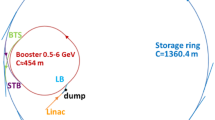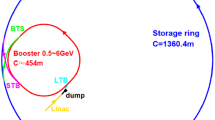Abstract
Purpose
The High Energy Photon Source (HEPS) is a synchrotron radiation source with an ultrahigh brightness and under construction in China. Its accelerator system is comprised of a 6-GeV storage ring, a full energy booster, a 500-meV Linac and three transport lines. With deepening investigations on the physics designs of the storage ring and the booster, the physics scheme of the Linac has evolved through multiple versions.
Methods
The final version of the Linac, including the electron gun, bunching system and main accelerator, has been determined. The Linac is an s-band normal conducting electron linear accelerator with a very high bunch charge and a large bunch charge range.
Results
Based on simulations, the Linac could provide electron bunches with charge greater than 8.5-nC, meeting the energy spread and emittance requirements.
Conclusions
This paper first reviews the evolution and main considerations for different design versions and then describes the physics design and dynamic simulation results of the final scheme in detail.











Similar content being viewed by others
References
Yi Jiao et al., J. Synchrotron Rad. 25, 1611–1618 (2018)
Z. Duan et al., in Proceedings of 9th International Particle Accelerator Conference(IPAC'18), Vancouver, Canada, 2018, pp. 4178–4181. https://doi.org/10.18429/JACoW-IPAC2018-THPMF052
J.Y. Li et al., in Proceedings of 9th International Particle Accelerator Conference(IPAC'18), Vancouver, Canada, 2018, pp. 1394–1397. https://doi.org/10.18429/JACoW-IPAC2018-TUPMF058
Y.M. Peng et al., in Proceedings of 9th International Particle Accelerator Conference(IPAC'18), Vancouver, Canada, 2018, pp. 1407–1410. https://doi.org/10.18429/JACoW-IPAC2018-TUPMF062
HEPS Project Proposal, 2017
C. Meng, Y. Jiao, J.Y. Li, S. Pei, Y.M. Peng, and H.S. Xu, in Proceedings of 9th International Particle Accelerator Conference(IPAC'18), Vancouver, Canada, 2018, pp. 1401–1403. https://doi.org/10.18429/JACoW-IPAC2018-TUPMF060
Y.M. Peng, J.Y. Li, C. Meng, S. Pei, and H.S. Xu, in Proceedings of 9th International Particle Accelerator Conference(IPAC'18), Vancouver, Canada, 2018, pp. 1411–1413. https://doi.org/10.18429/JACoW-IPAC2018-TUPMF063
H.S. Xu and N. Wang, in Proceedings of 9th International Particle Accelerator Conference(IPAC'18), Vancouver, Canada, 2018, pp. 2968–2970. https://doi.org/10.18429/JACoW-IPAC2018-THPAF012
H. S. Xu, Z. Duan, J. Y. Li, Y. M. Peng, S. K. Tian, and N. Wang, in Proceedings of 9th International Particle Accelerator Conference(IPAC'18), Vancouver, Canada, 2018, pp. 2971–2974.https://doi.org/10.18429/JACoW-IPAC2018-THPAF014
S. Pei et al., in Proceedings of 9th International Particle Accelerator Conference(IPAC'18), Vancouver, Canada, 2018, pp. 1404–1406.https://doi.org/10.18429/JACoW-IPAC2018-TUPMF061
C. Meng et al., in Proceedings of 10th International Particle Accelerator Conference(IPAC'19), Melbourne, Australia, 2019, pp. 1008–1011.https://doi.org/10.18429/JACoW-IPAC2019-MOPTS067
W.B. Herrmannsfeldt, EGUN: an electron optics and gun design program, SLAC-331, 1988
Lloyd M. Young, James H. Billen, Parmela, LA-UR-96-1835
Y. H. Chin, Y. Shobuda, and K. Takata, in Proceedings of 22nd Particle Accelerator Conference (PAC'07), Albuquerque, NM, USA, 2007, paper THPAN036, pp. 3306–3308
A.W. Chao, Physics of Collective Beam Instabilities in High Energy Accelerators (Wiley, New York, 1993), p. 141
M. Borland, elegant: a flexible SDDS-compliant code for accelerator simulation, advanced photon source LS-287, 2000
V. Balakin, A.Novokhatsky and V.Smirnov, in Proceedings of the 12th International Conferene on High Energy Accelerators, Fermilab, 1983, p.119–120
Acknowledgements
The authors would like to thank the colleagues in the HEPS accelerator team for their fruitful suggestions and comments. This work is supported by the High Energy Photon Source (HEPS) project, a major national science and technology infrastructure project; the National Natural Science Foundation of China under Grants (11705214, 11675174); and the Youth Innovation Promotion Association CAS (2019016).
Author information
Authors and Affiliations
Corresponding authors
Rights and permissions
About this article
Cite this article
Meng, C., He, X., Jiao, Y. et al. Physics design of the HEPS LINAC. Radiat Detect Technol Methods 4, 497–506 (2020). https://doi.org/10.1007/s41605-020-00205-w
Received:
Revised:
Accepted:
Published:
Issue Date:
DOI: https://doi.org/10.1007/s41605-020-00205-w




